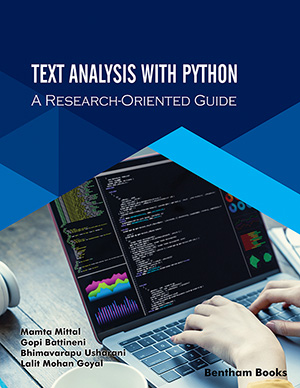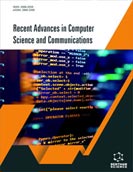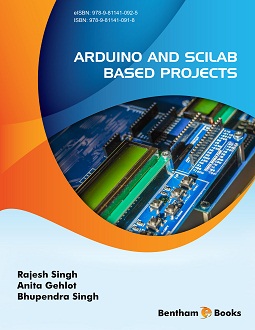Preface
Page: i-ii (2)
Author: Mamta Mittal, Gopi Battineni, Bhimavarapu Usharani and Lalit Mohan Goyal
DOI: 10.2174/9789815049602122010001
Introduction
Page: 1-17 (17)
Author: Mamta Mittal, Gopi Battineni, Bhimavarapu Usharani and Lalit Mohan Goyal
DOI: 10.2174/9789815049602122010002
PDF Price: $15
Abstract
In this chapter, the basic idea of what text data is, along with the definition of natural language and techniques involved in it has been clearly explained. Besides this, the framework of text mining and its workflow framework is explained.
Introduction to Python
Page: 18-34 (17)
Author: Mamta Mittal, Gopi Battineni, Bhimavarapu Usharani and Lalit Mohan Goyal
DOI: 10.2174/9789815049602122010003
PDF Price: $15
Abstract
This chapter discusses a brief introduction to the python programming language, the core Python language, and important libraries for natural language processing by using different IDEs like Anaconda and Google Co laboratory.
Data Loading and Pre-Processing
Page: 35-47 (13)
Author: Mamta Mittal, Gopi Battineni, Bhimavarapu Usharani and Lalit Mohan Goyal
DOI: 10.2174/9789815049602122010004
PDF Price: $15
Abstract
This chapter provides details about importing some predefined Python libraries, various data pre-processing techniques, and visualization techniques using various modules in python.
Text Mining
Page: 48-77 (30)
Author: Mamta Mittal, Gopi Battineni, Bhimavarapu Usharani and Lalit Mohan Goyal
DOI: 10.2174/9789815049602122010005
PDF Price: $15
Abstract
This chapter presents text mining and its importance, different open-source libraries for natural language processing, data collection, preprocessing concepts, feature selection, and feature extraction techniques, along with visualization techniques.
Text Classification in Python
Page: 78-120 (43)
Author: Mamta Mittal, Gopi Battineni, Bhimavarapu Usharani and Lalit Mohan Goyal
DOI: 10.2174/9789815049602122010006
PDF Price: $15
Abstract
Text classification is an ML technique that assigns a set of predefined tags to open text, and text classifiers have been used to structure, organize, and categorize any sort of text data ranging from documents, files, medical studies, to the overall web. This chapter will provide you with the text classification techniques in python. In addition, it focuses on training a supervised learning model to do text classification with a real-time case study.
Text Clustering in Python
Page: 121-158 (38)
Author: Mamta Mittal, Gopi Battineni, Bhimavarapu Usharani and Lalit Mohan Goyal
DOI: 10.2174/9789815049602122010007
PDF Price: $15
Abstract
In this chapter, we learn
about clustering and how document and text clustering can be performed. This
chapter explains the real-time applications of text clustering and the
differences between soft and hard clustering types. The clustering algorithms,
including KNN, hierarchical and Fuzzy clustering, were used . Fuzzy clustering
or soft clustering types can add better value performance-wise than the other two
clustering algorithms. Besides, we also presented how to conduct text
clustering in python using unsupervised machine learning techniques. To explain
this in detail, the IRIS dataset is considered famous in UCI Machine learning
Repository and well presented with python script.
Fuzzy Logic in Text Mining Using Python
Page: 159-190 (32)
Author: Mamta Mittal, Gopi Battineni, Bhimavarapu Usharani and Lalit Mohan Goyal
DOI: 10.2174/9789815049602122010008
PDF Price: $15
Abstract
This chapter introduces about fuzzy logic, its membership functions, and rules followed by various text mining concepts using the fuzzy logic using python. Different open-source libraries for fuzzy logic, preprocessing concepts in fuzzy logic text mining, different feature extraction techniques, fuzzy clustering concepts, classification in fuzzy text mining, fuzzy association rule mining concepts, and visualization in fuzzy text mining are presented.
Deep Learning for Text Mining
Page: 191-248 (58)
Author: Mamta Mittal, Gopi Battineni, Bhimavarapu Usharani and Lalit Mohan Goyal
DOI: 10.2174/9789815049602122010009
PDF Price: $15
Abstract
This Chapter presents about deep learning basics, deep learning implementation in Python, and text mining concepts utilising several deep learning models such as Feed Forward Neural Network, Convolutional Neural Network, Multi- Layer Perceptron, Recurrent Neural Network, and Long Short-Term Memory.
Subject Index
Page: 249-254 (6)
Author: Mamta Mittal, Gopi Battineni, Bhimavarapu Usharani and Lalit Mohan Goyal
DOI: 10.2174/9789815049602122010010
Introduction
Text Analysis with Python: A Research-Oriented Guide is a quick and comprehensive reference on text mining using python code. The main objective of the book is to equip the reader with the knowledge to apply various machine learning and deep learning techniques to text data. The book is organized into eight chapters which present the topic in a structured and progressive way. Key Features - Introduces the reader to Python programming and data processing - Introduces the reader to the preliminaries of natural language processing (NLP) - Covers data analysis and visualization using predefined python libraries and datasets - Teaches how to write text mining programs in Python - Includes text classification and clustering techniques - Informs the reader about different types of neural networks for text analysis - Includes advanced analytical techniques such as fuzzy logic and deep learning techniques - Explains concepts in a simplified and structured way that is ideal for learners - Includes References for further reading Text Analysis with Python: A Research-Oriented Guide is an ideal guide for students in data science and computer science courses, and for researchers and analysts who want to work on artificial intelligence projects that require the application of text mining and NLP techniques.






















